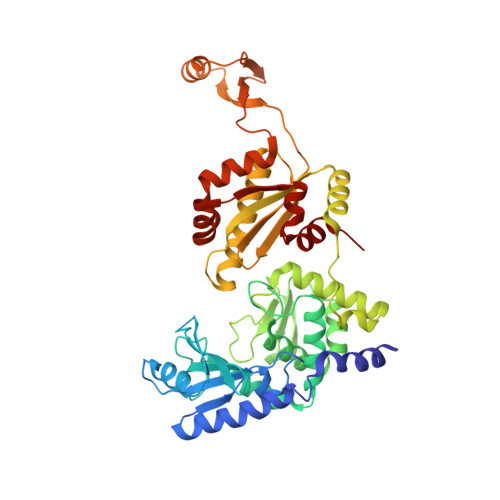Divergent evolutions of trinucleotide polymerization revealed by an archaeal CCA-adding enzyme structure.
Okabe, M., Tomita, K., Ishitani, R., Ishii, R., Takeuchi, N., Arisaka, F., Nureki, O., Yokoyama, S.(2003) EMBO J 22: 5918-5927
- PubMed: 14592988
- DOI: https://doi.org/10.1093/emboj/cdg563
- Primary Citation of Related Structures:
1UET, 1UEU, 1UEV - PubMed Abstract:
CCA-adding enzyme [ATP(CTP):tRNA nucleotidyltransferase], a template-independent RNA polymerase, adds the defined 'cytidine-cytidine-adenosine' sequence onto the 3' end of tRNA. The archaeal CCA-adding enzyme (class I) and eubacterial/eukaryotic CCA-adding enzyme (class II) show little amino acid sequence homology, but catalyze the same reaction in a defined fashion. Here, we present the crystal structures of the class I archaeal CCA-adding enzyme from Archaeoglobus fulgidus, and its complexes with CTP and ATP at 2.0, 2.0 and 2.7 A resolutions, respectively. The geometry of the catalytic carboxylates and the relative positions of CTP and ATP to a single catalytic site are well conserved in both classes of CCA-adding enzymes, whereas the overall architectures, except for the catalytic core, of the class I and class II CCA-adding enzymes are fundamentally different. Furthermore, the recognition mechanisms of substrate nucleotides and tRNA molecules are distinct between these two classes, suggesting that the catalytic domains of class I and class II enzymes share a common origin, and distinct substrate recognition domains have been appended to form the two presently divergent classes.
Organizational Affiliation:
Department of Biophysics and Biochemistry, Graduate School of Science, University of Tokyo, 7-3-1 Hongo, Bunkyo-ku, Tokyo 113-0033, Japan.

















